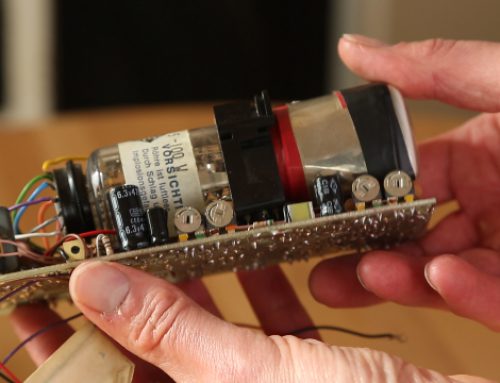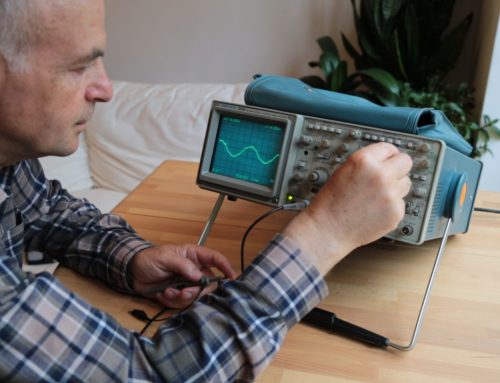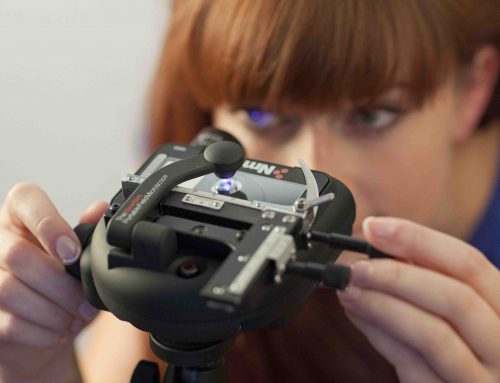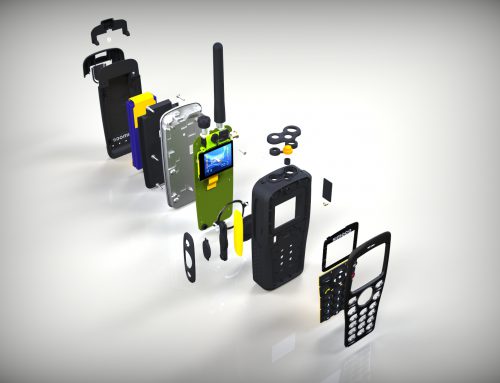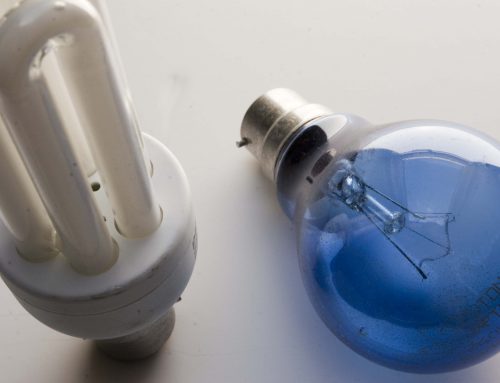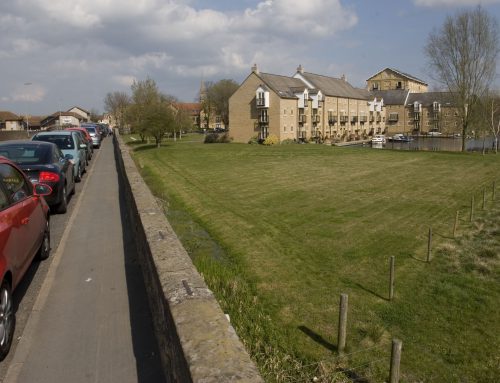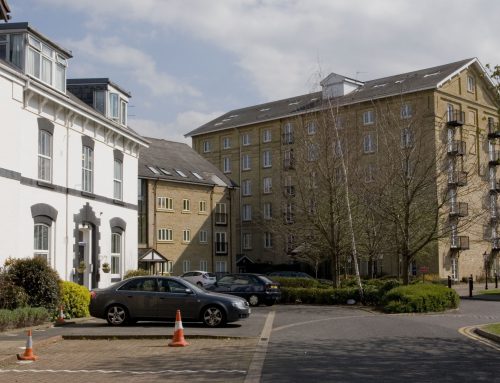In part 2 David explained how Cambridge Consultants fell into receivership, causing him to start up a hi-fi design business, before joining a precision instruments company. In Part 3 David talks about his development work on the innovative ‘flat’ cathode ray tube for Sinclair’s TV80 pocket television, and describe some of the interesting projects he has worked on since the Sinclair empire collapsed in the late 1980s.
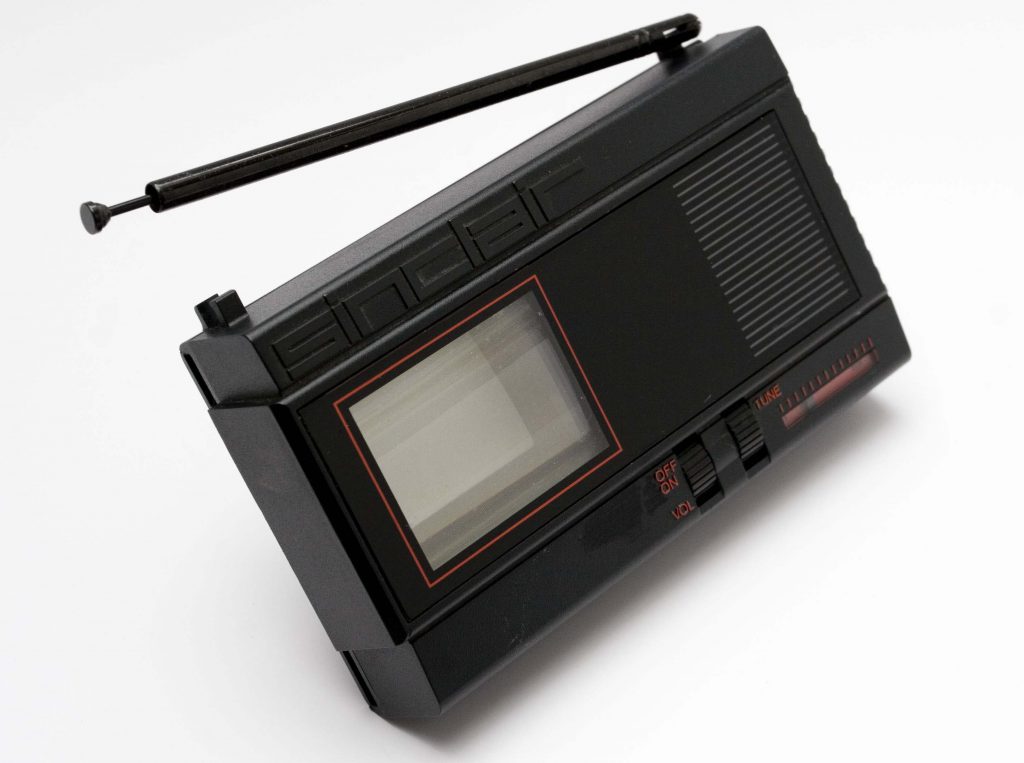
The FTV1, otherwise known as the TV80
At his new base in Cambridge’s King’s Parade, Clive Sinclair focussed almost all his efforts on the production of the Sinclair ZX80 home computer, which would eventually lead to the ZX81 and the hugely successful Spectrum. In the mean time, back at the Enderby’s Mill site in St Ives, David and a few other engineers were left working on ways to mass manufacture a flat television tube for the TV1B pocket television’s successor. Since the NRDC (National Research Development Council) and NEB (National Enterprise Board) had split the old company into pieces so that they could sell off the profitable parts and recoup a little of their investments, the budget for developing the flat tube was low, resulting in very slow progress.
“I was working with a chap called Robin Colclough who was a physicist,” David recalls. “He was definitely a tube man and a very clever bloke, but after a while he got a bit nervous that Sinclair Radionics had gone, that Clive’s company was down to about 10 people and the tube was a long, long way from production. So Robin left the project and it was down to me to work on setting up a production line to mass produce these tubes.
“At this point we were working on the prototype in a shed at the mill site that we called the Dircam. It was the first building on the left when you entered the site, on the other side of the mill house from what we called The Chapel. That was the boiler house for the big chimney, which Bushy eventually pulled down.
“Looking back I can see that before there was any capital input from Clive’s computer business, everything was paid for by the NRDC, who were, strictly speaking, only meant to be paying for half of the costs!
“Clive was based completely in King’s Parade and I’m not sure exactly what he was doing. We didn’t have a flat tube at that stage so I’m not quite clear if they were working on the electronics for the television or whether it was just the ZX80. But when the computer side eventually started generating a lot of money it became relatively easy to progress the tube.
“We needed equipment to, for example, vacuum-form soda glass – which is ordinary window glass – into the right shape. When I joined we had nothing that looked as though it could be made at all. The problem was that if you mould different kinds of glass, the thermal expansions of the materials don’t match and so they are difficult to seal together without them cracking. They had made a pressed-glass enclosure when I arrived but they hadn’t managed to seal it properly. That was when I said ‘Look, let’s try and vacuum-form soda glass.’ For that we were just taking an ordinary sheet of glass, heating it up to the appropriate temperature and then applying a vacuum to draw it down onto the mould that we had made.”
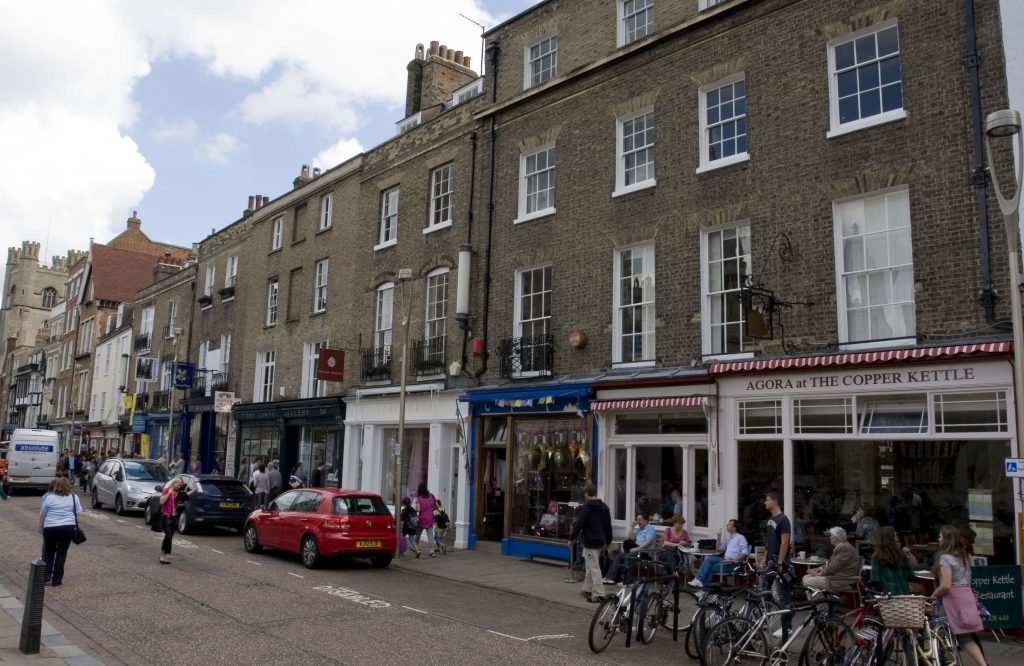
King’s Parade as it is today. At the start of the 1980s, Sinclair and his team were based on the upper floors of Number 6
Bending the Tube
Given that there were no other pocket televisions on the market using flat screens, and Telefunken – providers of the TV1B’s tube – didn’t make anything similar, David and his colleagues had to use trial and error to find the best way to produce their tube parts. As history now reveals, Sony were working on their Watchman flat CRT pocket television at the same time, but the team in St Ives had no information as to how the Japanese technology giants were solving the problem.
Perhaps the best solution would have been to ask Telefunken, or some other well-established tube manufacturer, to develop the component on behalf of Sinclair Radionics at their own factory, but Sinclair was determined to try to cut costs by refining the process in-house. “Clive was always raving about the tube he’d used before as being rather over-engineered and quite expensive and it was also the wrong aspect ratio to view,” explains David. “But like all things to do with manufacturing, every factor of 10 in terms of output is significantly challenging because you need to use a different method. We had to develop the processes in the Dircam shed at the mill site, and that included the vacuum deposition of the screen, designing the equipment to manufacture the cathodes, and finding a method of aligning all the electrodes and plates that make up a tube.
“The way we did it was to hold all the plates in a jig. They have all got little tags on them, so you introduce a hot glass bar on each side and plunge the tags into the glass, and that holds everything in exactly the right position. So we had heaters that melted the glass for this purpose. Of course, none of the assembly is in the vacuum at that point – you assemble the whole innards of the tube as one unit while it is outside.”
One of the biggest challenges David and his team faced was making sure the tube did not use too much power, which would drain the battery rather quickly. As Rick Dickinson explained in his interview with Polymath Perspective, Sinclair wanted the television to use an extremely slim-line battery, which Polaroid made to power their instant cameras. It was therefore imperative that the design of the tube was compatible with the battery specification.
”In order to get the electrons to be emitted from a conventional cathode ray tube,” explains David, “you have to heat the cathode up to about 800 degrees, or something like that, but if you are using battery power you can’t afford to use a significant amount of power because it will drain the battery very quickly. You just have to have a very low power tube, but the heaters in a lot of conventional old-fashioned power valves are rated at something like five Watts. Well, that would be absurd because the battery would be flat in no time.
“The way we conserved power was to use 16 microns thick tungsten wire – which is just over half a thou in diameter – and have quite a long length of it. I suppose it was about one centimetre long. In the middle it got up to the right temperature but it stayed cold at the edges where it was attached to an electrode at one end and a tensioning spring at the other.
“The wire had to be coated in a special mixture of oxides because tungsten wire won’t emit on its own, so we added a ceramic coating made of something like barium and strontium oxide, and when we heated those substances they would emit.
“We had to place that 16 micron wire exactly in the middle of the five thou grid hole that monitored the beam. The tolerances were ridiculously low and it was a challenge to work with such very fine wire.
“So we had to develop equipment to coat the wire, strip it to exactly the right length and then attach it at each end. For that we started with quite a long bit of wire which was located on two Vs to ensure that it was the right height and the right distance away from everything. This half a thou wire had to be located right in the middle of the five thou hole and we had to weld the tungsten at both ends, one to a fixed electrode, the other to a spring so that the wire was under tension.
“And, at the same time, we had to develop a means of doing all of this at the rate of one tube a minute, or something like that. We also had to develop all the machinery to make it as well because there was nothing you could buy off the shelf. That was the case with all the equipment, really.”
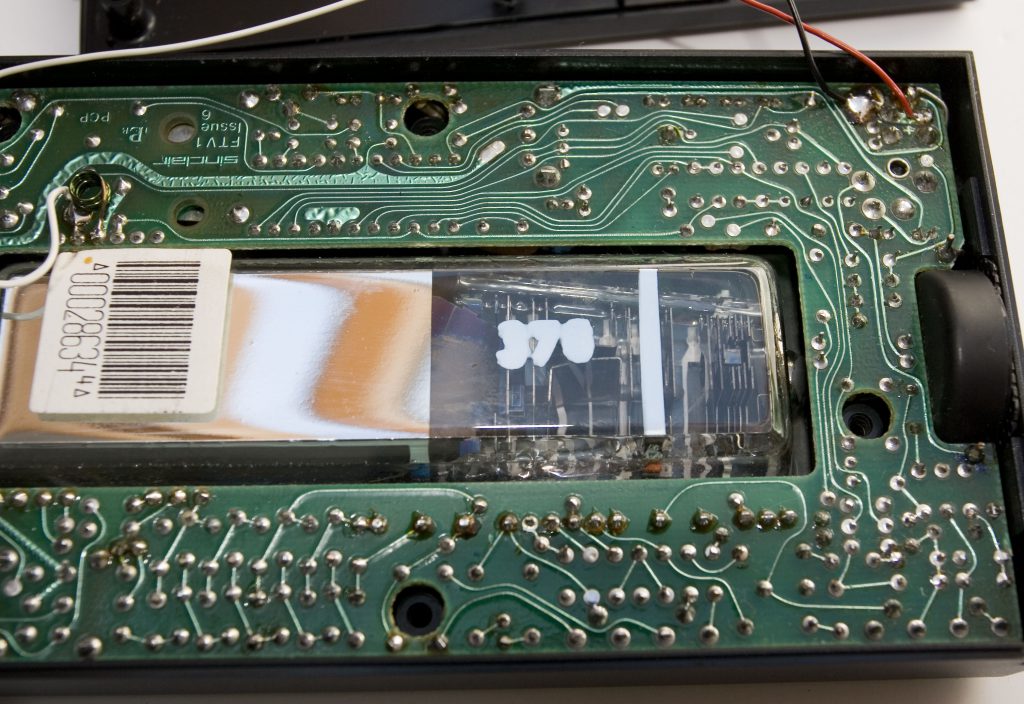
The finished tube, seen from the back
Better Never than Late?
Although the early working prototypes for the flat-screen television had been demonstrated some time around 1978, the TV80, as it was eventually called, didn’t make it onto the high street until 1983. Unfortunately for Sinclair, while those five years were passing the market had moved on. Sony managed to launch the first of their Watchman portable flat-screen televisions in 1982, just beating Sinclair to it, although the Watchman’s European launch didn’t happen for another couple of years. More significantly, Casio introduced the first portable LCD television in the spring of 1983, and only a year later Epson released the ET-10 colour portable, putting an end to the flat screen tube dream and signalling the start of a new era or technology.
“The company only made 300,000 tubes because Sinclair wasn’t really able to sell them,” confirms David. “I can’t remember being particularly conscious of Sony’s product because I think we were probably at a lower price, and Clive was always absolutely convinced he was going to outsell everybody, but it was at a time when LCDs were just about to come in, so the technology was just too late, really.
“But we did set up a pretty big plant to make the tube at the Timex Electronics factory in Dundee, which probably cost £5,000,000, so it was a big operation and the computers funded all the equipment that we had to buy, right the way through.
“Clive moved into Willis Road after King’s Parade, right behind where the post office used to be in Mill Road, but I was at the mill in St Ives until he set up offices at Milton Hall. I moved there then and that’s when we basically shut up shop at St Ives completely.”
“I still worked on different gadgets for Clive, including printers, Microdrives and things like that. I was doing that until Clive decided that he’d sell to Alan Sugar, and when Sugar took over all of the computer business Milton was effectively shut down.”
Ever optimistic, David didn’t let the demise of Sinclair Research dampen his enthusiasm for business, and was soon looking to start up a fresh venture with a new partner.
“At the time I was told my services were no longer needed at Sinclair Research I was talking to a chap who worked for STC in Harlow,” recalls David, “and we began trying to get a business off the ground making liquid crystal displays of a particular kind. This was a memory LCD and, in a way, it was like the Kindle devices you get now. The idea was that you put your pattern in and it remained like that for evermore. STC had developed this technology and they were looking to exploit it, so this STC chap and I got some backing from the city and set up Image Displays Ltd. This was probably around 1985.
“I remember I was driving up and down the A11 to Harlow all the time because we had a clean room within the STC Harlow complex. It was a very expensive room where you had to wear special clothing, just like those where they make silicone chips. The air was filtered because we were trying to make an LCD with a resolution equivalent to a fax, which is 200 lines per inch, and when you are trying to pattern glass at 200 lines per inch it is quite difficult. You have to ensure there are no dust particles or anything anywhere and that’s why you have to wear a special suit and mask. It’s a bit of a nightmare.
“We had to have a special chip made and I got it so we were directly mounting them on the glass all the way around the edge of the display. That worked quite nicely but it was really quite a difficult thing to fund because, even though we were starting with £250,000, you have to spend at quite a high rate in order to be able to demonstrate prototypes and get interested people involved. And when you do that you tend to run out of money very quickly. So in the end that business was sold to a Norwegian company and I’m sure it has folded by now.”
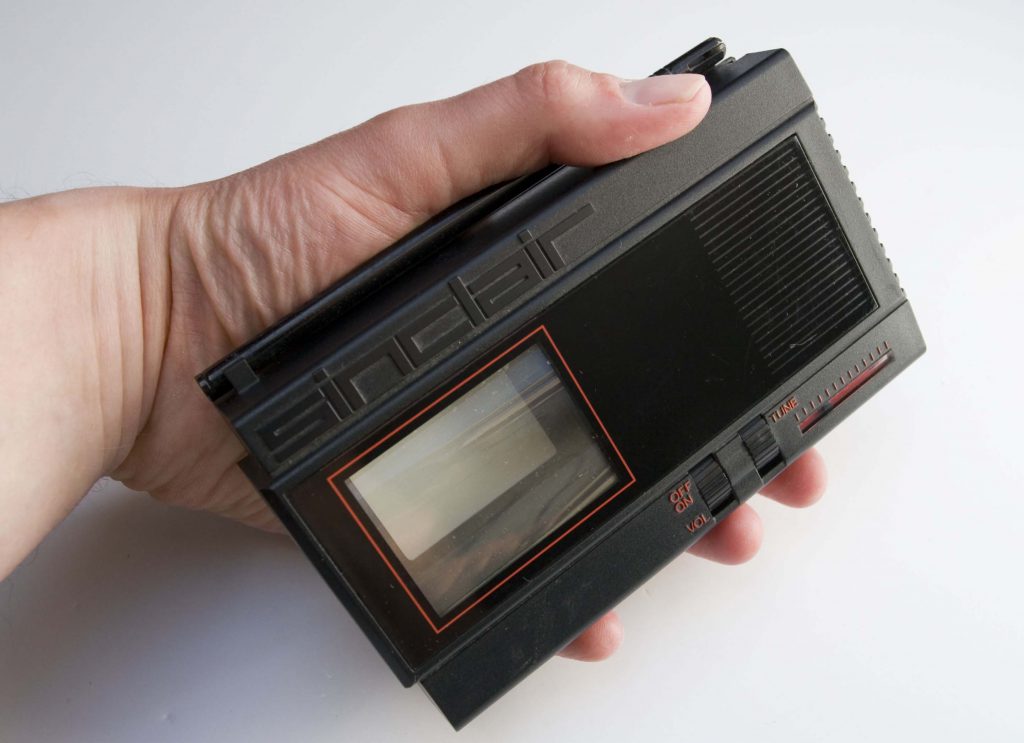
Fitting the tube, circuit, speaker, controls and battery in the small case was a challenge
Working from Home
After the disappointment of not being able to carry on with the LCD project, David decided to take a different approach to his working altogether, and began freelancing from his home in Cambridgeshire.
“I did that when I realised that things had got to the stage where there was really good computer-aided design,” he explains. “I used a thing called Power CAD and worked for people like Clive Sinclair and Jim Westwood. The company Jim was working for made a rival to the BSkyB Satellite aerial and I did the mouldings and things for that.
“I continued working freelance until I retired about 10 years ago. That setup was very nice and easy really. There was no stress and you have no overheads to speak of. And I was always pretty busy.
“One of the very first clients I had was someone who had once approached Cambridge Consultants. He had originally wanted us to design check weighing equipment for Mars and people like that, where you weigh the products as they go through on the conveyor belt. When that particular fellow returned, I worked on a series of CCTV products for him, this time using very much better optical systems, including some where the lenses were eight or 10 inches in diameter and cost an absolute fortune; but you could look at things five miles away!
“The army used it for spying on what people were doing and the chap was also working for various prisons in Northern Ireland and things like that, always with much better optical systems than the conventional street monitor.”
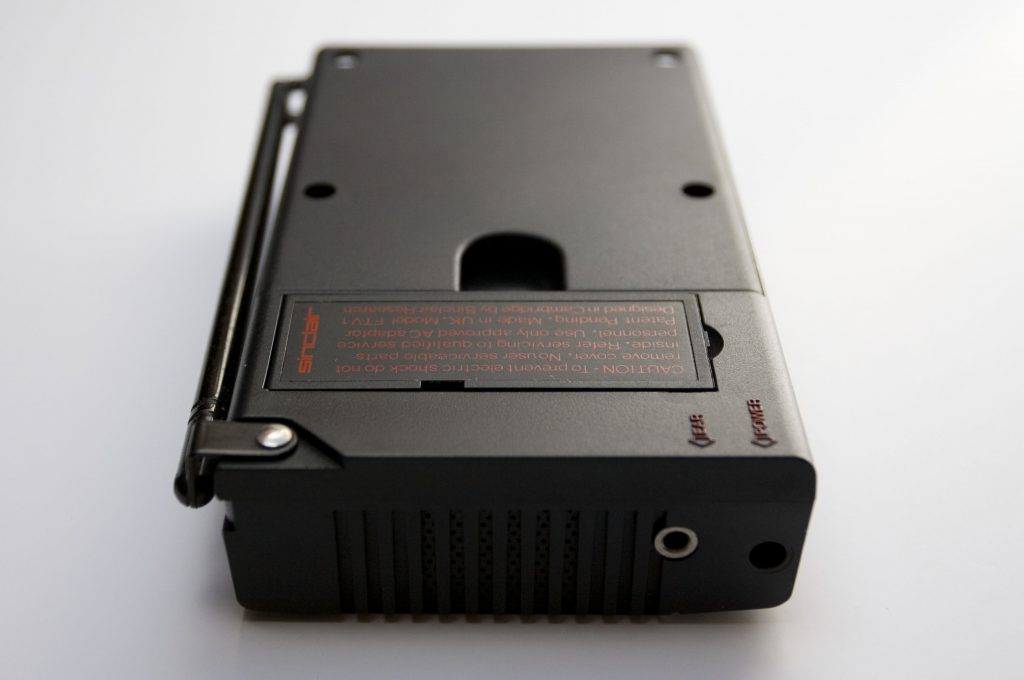
The back of the TV80
Computer Days
Today, Cambridge Consultants is still a thriving business, as are many other technology companies based in the Cambridge region, which owe a debt of gratitude to the businesses set up in the 1960s by David Southward and Tim Eiloart. Long since retired, David is in a position to look back at his career and objectively observe its many ups and downs. Reflecting on technology and manufacturing in general, David sees the evolution of the computer as the one development which has resulted in the biggest change.
“Everything now is driven by a computer,” he says. “It has magicked the way. You can print in 3D and you can machine every known metal with water jets or lasers. It has just completely transformed the place really. I suppose the high capital cost of equipment has actually taken over from the extreme accuracy of workers. When we had instrument workers in the past they were capable of doing very fine work, but now that is not really necessary because you get it accurate with ‘numerically controlled’ equipment, and that’s much cheaper overall. So it has transformed things. I wish I’d had a computer at the start of my life because it does make life so much better.”
It is understandable that David sees computers in such a positive light, given that they offer relatively easy solutions to certain design and production problems which he struggled with in the past, but when it is suggested to him that perhaps designers today don’t get the chance enjoy experiencing the process of making things, he admits that that is an issue.
“Well, I suppose people are removed from understanding the properties of things. People have changed a lot. Now nobody services their car or knows how to change a wheel really. At least my children don’t, which is a great scandal!
“I have a Ferrari in my barn which I had in the same state that it is for the last 30 years or something ridiculous. I always said that when I’m retired I was going to rebuild it but now I’ve retired I have no wish whatsoever to get my hands dirty!” TF
Part 1 of our interview with David can be found here: Part 1
Part 2 of our interview with David can be found here: Part 2
Interested in Sinclair? See also our interviews with Designers Brian Flint and Rick Dickinson:

